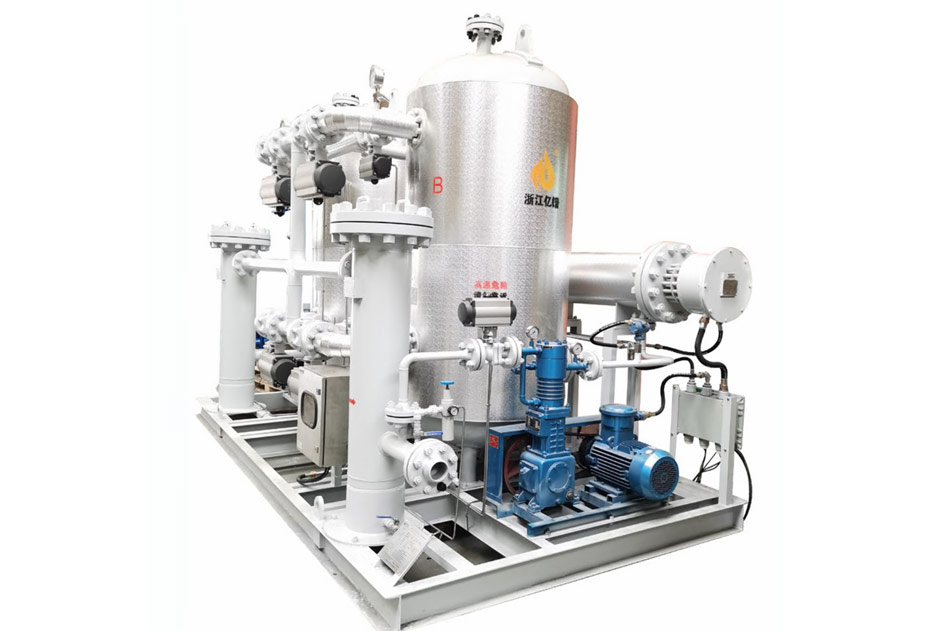LNG Refueling Station Dehydration Solutions
Industry Pain Points
Low-Temperature Ice Blockage Risk: LNG temperature is as low as -162℃. Residual moisture forms ice crystals during the liquefaction process, blocking pipelines and valves and causing refueling interruptions. The average annual downtime loss per station exceeds 800,000 yuan.
Equipment Corrosion and Shortened Service Life: Moisture combines with acidic components (e.g., CO₂, H₂S) in natural gas to form acidic ice crystals at low temperatures, corroding the inner walls of storage tanks and BOG compressors. This increases maintenance costs by 35%.
Calorific Value Fluctuations and Measurement Disputes: Each 1ppm of moisture reduces the calorific value of LNG by 0.01%, triggering complaints from end-users. Annual losses from measurement disputes are approximately 300,000-500,000 yuan.
Defects of Traditional Technologies: The adsorption efficiency of molecular sieves drops sharply by 60% below -50℃; benzene-series compounds precipitate from triethylene glycol (TEG) systems under low-temperature conditions, contaminating LNG.
System Overview
Through the “cryogenic coalescence – low-temperature adsorption – nanomembrane precision dehydration” technology chain, Yipu LNG Refueling Station Dehydration System achieves:
- Ice Blockage Prevention: Ensures stable operation under -162℃ working conditions.
- Energy Consumption Revolution: Cold energy recovery reduces the system’s net energy consumption to 1/10 of that of traditional solutions.
- Ultra-Long Service Life: The design life of core components is 10 years, triple the industry average.
Solution Approach
Yipu LNG Refueling Station Dehydration Solution
| Module | Technical Highlights | Performance Parameters |
|---|---|---|
| Cryogenic Coalescer | Aluminum alloy finned tube + glass fiber coalescing layer | Liquid droplet removal rate ≥99.5%, pressure loss ≤0.003MPa |
| Low-Temperature Adsorption Tower | Vacuum insulation design, resistant to -196℃ | Dew point -80℃, adsorbent service life ≥5 years |
| Nanomembrane Module | Zirconia ceramic membrane, anti-freeze expansion design | Water molecule retention rate ≥99.9% |
| BOG Treatment System | Integrated cold box to recover liquefaction cold energy | BOG dehydration energy consumption ≤0.02kWh/Nm³ |
| Intelligent Control | Dew point laser sensor + AI dynamic adjustment | Control accuracy ±0.5℃ |
Applicable Scenarios:
- Pre-dehydration at LNG refueling stations
- Pretreatment at LNG liquefaction plants
- Floating Storage and Regasification Units (FSRU)
Technical Principles
Yipu Three-Stage Deep Dehydration Process:
- Preliminary High-Efficiency Separation (Stage 1):The axial hypergravity separator removes 95% of free water within 0.5 seconds, with a treatment capacity of up to 3000 Nm³/h.
- Intelligent Condensation (Stage 2):The variable-frequency refrigeration unit automatically adjusts according to gas volume, cooling the gas from 40℃ to 3℃ and reducing the dew point to -15℃.
- Composite Adsorption (Stage 3):Hydrophobic molecular sieves (patented 3A-CNG model) achieve deep dehydration under 20MPa high pressure, maintaining a stable dew point of -60℃ (moisture ≤1mg/m³).
- Energy Recovery:Uses compressor waste heat to regenerate adsorbents, reducing energy consumption by 60%.
Core Advantage
| Advantage | Details |
|---|---|
| Customized on Demand | Meets special working conditions; provides professional non-standard customization |
| Low Cost | Adopts cyclic regeneration process; significantly reduces operating costs |
| High Stability | Dual-tower structure with small pressure fluctuation; low noise and continuous gas supply |
| Fully Automatic Operation | Easy to operate, reducing labor input; improves efficiency |
| High Safety | Presets multi-level safety protection measures; supports automatic alarm |
| Low Failure Rate | Maintains low failure rate after 10,000 hours; high durability with almost no maintenance required |
Technical Strength
Leading Adsorption Dehydration Technology
Uses high-performance molecular sieve adsorbents with high water absorption capacity and resistance to corrosion by acidic gases (H₂S/CO₂), ensuring deep dehydration with a dew point ≤-70℃.
The original hot nitrogen regeneration process reduces energy consumption by 30% compared with traditional electric heating regeneration, and integrates a waste heat recovery system to significantly improve energy efficiency.
Modular and Customized Design Capability
Core equipment adopts modular prefabrication, supporting rapid deployment (installation cycle shortened by 50%) and adapting to diverse scenarios such as offshore platforms, onshore gas fields, and LNG pretreatment.
Can customize single-tower, dual-tower, or multi-tower parallel systems according to customer needs, with a treatment capacity ranging from 10,000 to 1,000,000 Nm³/d, flexibly matching gas fields of different scales.
Intelligent Control and Remote Operation & Maintenance
Equipped with a PLC+IoT intelligent control system, it real-time monitors key parameters such as pressure, temperature, and dew point, supporting fault early warning and automatic adjustment.
Through cloud-based big data analysis, it optimizes the adsorption-regeneration cycle, extends the service life of molecular sieves, and reduces operation and maintenance (O&M) costs by 10%-15%.
Energy-Saving and Environmental Protection Technology
Features zero-emission design for regeneration exhaust gas, complying with international environmental standards such as EU CE and US EPA.
Energy consumption is 25%-40% lower than that of traditional triethylene glycol (TEG) dehydration systems, helping customers achieve carbon emission reduction goals.
Long-Cycle Operation Reliability
Molecular sieves adopt anti-pulverization coating technology, with a service life of over 5 years, reducing replacement frequency.
Key components (e.g., valves, instruments) are selected from international first-tier brands (e.g., Siemens, Emerson), with a Mean Time Between Failures (MTBF) of over 100,000 hours.
Strong R&D and Engineering Experience
Possesses more than 19 patents and software copyrights in dehydration technology; the R&D team is led by doctors and has in-depth cooperation with universities and colleges.
Has over 1,000 successful cases worldwide, covering extreme working conditions such as high-sulfur gas fields in the Middle East and low-temperature environments in the Arctic.
Product Advantage Comparison
| Indicator | Yipu System | TEG Dehydration | Molecular Sieve Adsorption | Competitor Adsorption Systems |
|---|---|---|---|---|
| Dew Point | -80℃ (normal state) | Not applicable (benzene precipitation at low temperature) | -40℃ (failure at low temperature) | -60℃ (membrane prone to ice blockage) |
| Energy Consumption | 0.03kWh/Nm³ (including cold energy recovery) | 0.15kWh/m³ | 0.12kWh/m³ | 0.1kWh/m³ |
| Maintenance Cost | <0.01 RMB/Nm³ (5-year service life) | 0.12 RMB/Nm³ (TEG + replacement) | 0.08 RMB/Nm³ (2 replacements per year) | 0.2 RMB/Nm³ (membrane replacement) |
| Temperature Adaptability | -196℃~+50℃ | Only >-20℃ | Only >-30℃ | -100℃~+80℃ |
| Environmental Friendliness | Zero chemicals, zero emissions | Risk of benzene-series compound pollution | Difficult molecular sieve waste disposal | Non-recyclable after membrane pollution |
Typical Case
Project Name: An LNG Refueling Station in East China
Operating Conditions:
- Treatment Capacity: 50 tons/day, inlet gas temperature -145℃
- Water Quality: Water-saturated, CO₂ 200ppm
Dehydration Effect:
- Dew point reduced from saturated state to -85℃
- Ice blockage failures of refueling machines reduced to zero
Economic Benefits:
- Reduced annual downtime loss by 1.2 million yuan
- Saved 250,000 yuan in electricity costs annually through cold energy recovery

